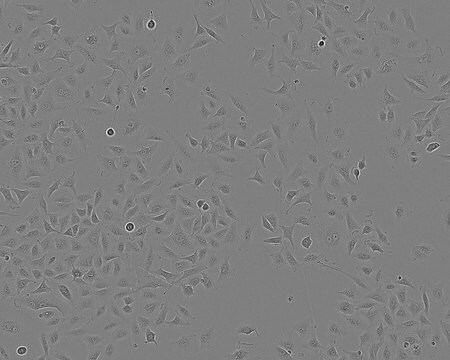3T3 L1 Cell Line from mouse
86052701, mouse embryo, Fibroblast-like
Synonym(s):
3T3L1 Cells, NIH-3T3-L1 Cells, NIH3T3-L1 Cells
Sign Into View Organizational & Contract Pricing
All Photos(1)
About This Item
UNSPSC Code:
41106514
Recommended Products
Product Name
3T3 L1 Cell Line from mouse, 86052701
biological source
mouse embryo
description
embryo
growth mode
Adherent
karyotype
2n = 40; Aneuploid with unstable karyotype
morphology
Fibroblast-like
products
Not specified
receptors
Not specified
technique(s)
cell culture | mammalian: suitable
shipped in
dry ice
storage temp.
−196°C
Cell Line Origin
Mouse Embryo
Cell Line Description
3T3 L1 is a continuous strain of 3T3 developed through clonal isolation. The cells are not contact inhibited. Cells can be induced to become adipose-like using the method described in the subculture routine information. Appearance of adipocytes can take weeks to achieve.
We would like to manage customer expectations with regard to the potential of the current 3T3 cell line stocks to differentiate into adipocytes. If you intend to use the cells for adipocyte differentiation please note: When cells are stimulated, using an appropriate protocol, differentiation may take several weeks to occur, e.g. 2 - 5 weeks, and the proportion of the population which differentiates can be limited. If you have previously used 3T3 cells from an alternative source we cannot guarantee the differentiation performance will be the same.
We are working to source a new stock of this cell line that has a higher rate of adipocyte differentiation potential which we aim to be able to offer in the future. When this is available we will update the cell line details on the website.
We would like to manage customer expectations with regard to the potential of the current 3T3 cell line stocks to differentiate into adipocytes. If you intend to use the cells for adipocyte differentiation please note: When cells are stimulated, using an appropriate protocol, differentiation may take several weeks to occur, e.g. 2 - 5 weeks, and the proportion of the population which differentiates can be limited. If you have previously used 3T3 cells from an alternative source we cannot guarantee the differentiation performance will be the same.
We are working to source a new stock of this cell line that has a higher rate of adipocyte differentiation potential which we aim to be able to offer in the future. When this is available we will update the cell line details on the website.
Application
3T3 L1 cell line from mouse has been used to study changes in lipopolysaccharide-induced inflammatory cytokine production and anti-inflammatory effects of galectin-3 in 3T3-L1 adipocytes. It has also been used in neutral red uptake assay (NRU) and neutral red release assay (NRR) as in vitro methods to assess eye irritation hazards of formulations and chemicals.
Culture Medium
DMEM + 2mM Glutamine + 10% Calf Serum (CS)
Subculture Routine
Split sub-confluent cultures (70-80%) 1:50 to 1:100 i.e. seeding at 2-4x10,000 cells/cm2 in a 75cm2 flask using 0.25% trypsin or trypsin/EDTA; 5% CO2; 37°C. Never allow the culture to become fully confluent and subculture every 3 days. To stimulate differentiation into adipocytes grow the cells to confluency using the DMEM + 10% calf serum. 2 days after confluency induce differentiation by adding 0.5 mM 3-isobutyl-1-methylxanthine (IBMX), 0.25uM Dexamethasone and 1ug/ml Insulin in DMEM with 10% Foetal Bovine Serum (FBS). After 2 days remove the IBMX and dexamethasone but maintain with insulin for another 2 days. On day 4, after inducing differentiation, and thereafter, culture the cells in DMEM with 10% FBS. Change medium every second day. Differentiation may take several weeks to occur e.g. 2 - 5 weeks. Differentiation begins in patches but with time a significant percentage of the population should change. Before any experiments on the differentiated cells incubate in serum-free DMEM for 2 hours.
Other Notes
Additional freight & handling charges may be applicable for Asia-Pacific shipments. Please check with your local Customer Service representative for more information.
Choose from one of the most recent versions:
Certificates of Analysis (COA)
Lot/Batch Number
Sorry, we don't have COAs for this product available online at this time.
If you need assistance, please contact Customer Support.
Already Own This Product?
Find documentation for the products that you have recently purchased in the Document Library.
Our team of scientists has experience in all areas of research including Life Science, Material Science, Chemical Synthesis, Chromatography, Analytical and many others.
Contact Technical Service

